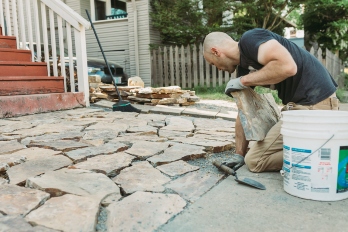This post is part of our ongoing series on manufactured, mobile, and modular homes.
To the naked eye, it can be almost impossible to tell the difference between manufactured houses and traditional site-constructed houses.
In most aspects, they’re exactly the same. They have foundations, siding, roofs, and all the finishes that make a house home-sweet-home.
The main difference between manufactured homes and site-constructed homes is the way they’re built. While site-built homes are put together right on a plot of land, manufactured homes are built in a warehouse and shipped in pieces to the property they’ll reside on, where they’re “installed” on top of a foundation.
Because of the difference in the building process, there are a few unique features of manufactured homes that need a little extra attention.
Here are the top 5 things to know about maintaining a manufactured home:
1. Foundation
Manufactured homes are built in a warehouse before being delivered to a property, so they have different foundation needs than homes that are built where they stand.
With manufactured homes, the most important things are to make sure they stay level and that their foundations remain in good shape.
Since most problems with leveling show up within the first year after installation, check the floors near corners and along the center of your home with a 6-foot level 90 days after installation, and again after one year. After that, a quick check every 3-5 years won’t hurt. If you find problems, give the contractor who did the installation a call.
If you bought a previously owned manufactured home, have a home inspector check the foundation and make sure the house is level before you complete the purchase. It’s still wise to check it every 3-5 years afterward to see if your home shifted.
Many manufactured homes have piers and anchors. Piers are usually made of concrete or metal and provide a stable foundation for your home. Anchors are set in the earth and hold it in place. Check the piers and anchors in the spring and fall. Cracks larger than 1/8 inch, leaning or buckling, and loose or corroded anchors are cause for concern. If you see any issues, have your contractor take a look right away.
2. Crawlspace
Manufactured homes commonly have pier or cement wall foundations. Both of these foundation types create an open crawlspace beneath the home that needs to stay well ventilated, have proper drainage, and have a barrier that prevents entry for pests.
Local building codes determine the number of vents you need for a manufactured home and its crawlspace, but one for every 150 square feet of the home is standard. You’ll want to keep vents or other obstructions from blocking these vents.
Many manufactured homes also have skirting (sheets of plastic or metal) that surround their base to enclose the crawlspace. Skirting often has strips of holes that allow air to move through the crawlspace. Spray your skirting down with a hose once or twice a year to keep the holes clear. If you find gaps or breaks in your skirting, tighten them back up, cover them with plastic or metal patches, or replace the section.
A few times a year, visually inspect your crawlspace for puddles. Puddles can indicate improper drainage and can lead to mold. If you find water, get a professional opinion right away.
Manufactured homes with skirting or another kind of enclosed crawlspace often have a vapor barrier. The vapor barrier is a sheet of plastic on the ground to prevent moisture from entering your crawlspace. If you don’t have a vapor barrier, it’s not an emergency, but you may want to talk to a contractor about having one installed.
Pro tip: Never vent your dryer under your manufactured home. Warm, damp air in a dark space creates the perfect conditions for mold and mildew.
3. Underbelly
Manufactured homes have a barrier made of strong, woven plastic stretched over their underside called an underbelly. It provides a layer of insulation, keeps everything above it dry, and prevents critters from entering your home.
Check the underbelly annually for rips or other openings. If you’re feeling handy, patching it is probably a job you can handle. You can buy plastic underbelly material and adhesives at a hardware store. If you’re not up for it, hire a pro to patch it up. Either way, fix it ASAP.
Contractors sometimes forget to patch holes they made in the underbelly while working beneath your home. After your contractor finishes the job, feel free to ask if they remembered to patch any holes they made.
4. Roof
Newer manufactured homes usually have slanted asphalt shingle roofs, but those built before 1982 may have flat or bowstring (slightly curved) roofs. Flat roofs are often covered in rubber, metal, or asphalt.
Snow and ice can be a problem for flat and bowstring roofs. And while roofs on newer manufactured homes are a bit more durable, transportation, installation, and settling can loosen roof seams and joints.
If you notice water stains or dampness on your home’s ceilings or walls, call a roofing professional right away. Even small amounts of water can cause problems with rot and mold.
Snow, ice, and pooling water are hard on your roof. Not only do they damage roofing materials, they also add a lot of weight, which can cause problems for your home’s structure. If you have issues with pooling water, or get snow or ice buildup on your roof, clean it off (working with a pro to do so is totally OK!).
To further maintain your roof:
- Check your roof in the spring and fall for debris and damage. Look for cracked, torn, missing, or worn-out roofing. Also, if you have gutters, clean them out when your check your roof. If you don’t have gutters, consider installing them. They can go a long way in preventing water damage.
- Check flashing around vents or walls. Flashing is the thin pieces of metal or plastic that go in corners to prevent leaks. If it’s corroded, separated, cracked, or otherwise damaged get it replaced ASAP.






